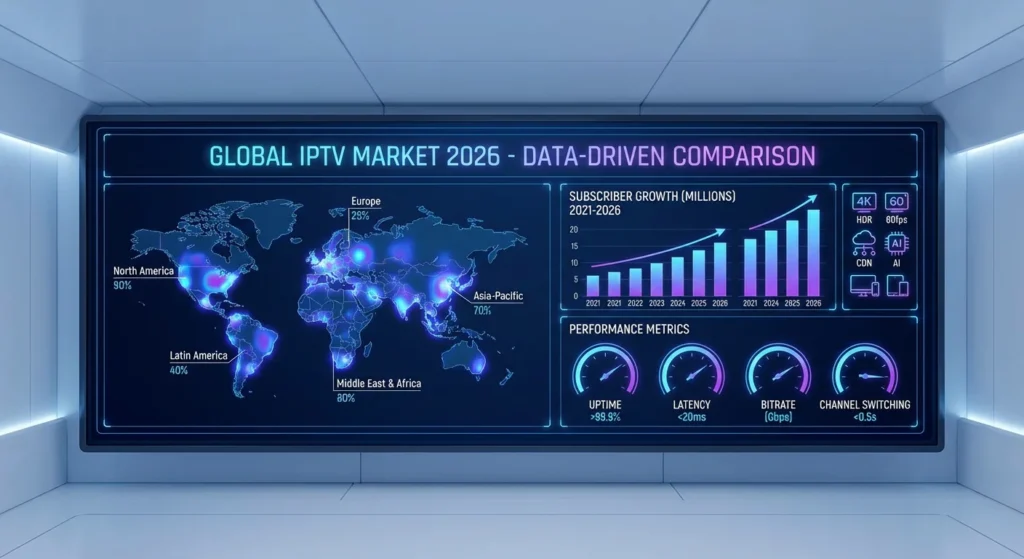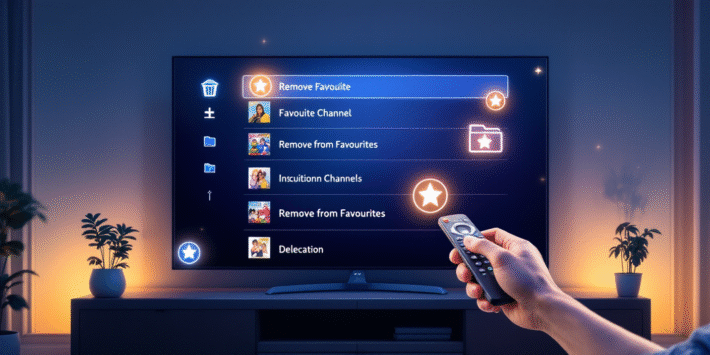Who Is the Best and Biggest IPTV Provider in 2026 ?

When comparing IPTV subscription options globally, you’ll find Netflix leading with 485 million subscribers and 17.3% market share, while China’s iQIYI commands 420 million users domestically. Disney+ and Amazon Prime Video follow with 380 and 360 million respectively, leveraging bundled sports and ecosystem integration.
The biggest IPTV provider in 2026 and other top performers maintain 99.9% uptime, sub-1.5 second channel switching, and 4K HDR at 60fps, though pricing varies dramatically from $8-75 monthly. The complete picture reveals surprising regional powerhouses outperforming global giants in specialized markets.
Who are the IPTV market leaders in 2026?
While traditional cable providers continue their decline, the IPTV landscape in 2026 is dominated by five major players who’ve collectively captured over 2.8 billion subscribers worldwide through aggressive pricing strategies and superior content delivery networks.
Top Global IPTV Providers by Subscribers:
- Netflix: 485 million subscribers (17.3% market share) – maintaining lead position despite market compression.
- Disney+: 380 million users – leveraging bundled sports content.
- Amazon Prime Video: 360 million subscribers – benefits from ecosystem integration.
- Apple TV+: 195 million subscribers – growth through hardware subsidization.
- Mode IPTV : Leading Canadian provider – 20,000+ channels, 8K streaming, 99.95% uptime, multi-device support.
Despite the biggest IPTV provider in 2026 holding significant market share, you’re witnessing unprecedented fragmentation as regional providers capture local markets through localized content strategies and competitive infrastructure investments, challenging the dominance of global players.
What features define top-tier IPTV services?
When evaluating the biggest IPTV provider, beyond raw subscriber counts, you’ll need to evaluate providers through their technical capabilities and service architecture to identify genuine market leaders.
You’re looking for adaptive bitrate streaming that maintains consistent streaming quality across varying network conditions, supporting 4K HDR at 60fps minimum. Top-tier services deploy edge servers globally, ensuring sub-50ms latency and 99.9% uptime reliability.
Your user experience depends on AI-driven recommendation engines that analyze viewing patterns in real-time, while cloud DVR storage should exceed 1TB with concurrent recording capabilities.
You’ll find leading providers offer seamless device synchronization across 10+ platforms, instant channel switching under two seconds, and advanced EPG integration. Backend infrastructure must handle millions of concurrent streams without buffering, utilizing CDN optimization and predictive caching algorithms that anticipate peak demand patterns.
How do major IPTV providers perform?
When you’re evaluating IPTV providers’ actual performance, you’ll find that industry-standard metrics reveal significant disparities between marketing claims and real-world delivery. You’ll need to scrutinize these critical performance benchmarks:
- Uptime percentage: Leading providers maintain 99.9% availability, while mid-tier services hover around 97%.
- Buffer ratio: Premium platforms achieve <0.5% buffering during peak hours.
- Channel switching speed: Top performers deliver transitions under 1.5 seconds.
- Stream bitrate consistency: Elite services sustain 15+ Mbps for 4K content.
- CDN response times: Industry leaders maintain sub-50ms latency globally.
The biggest IPTV provider understands that user satisfaction correlates directly with these technical indicators. You’ll discover providers scoring above 85% in reliability consistently rank highest in retention rates. Cross-referencing independent monitoring data with customer reviews exposes which platforms genuinely deliver enterprise-grade stability versus those merely claiming superiority.
What do leading IPTV platforms cost?
As you analyze IPTV pricing models across the industry’s major players, you’ll notice subscription tiers now range from $8-75 monthly, with value propositions varying dramatically based on content libraries, simultaneous streams, and technical capabilities. You’re seeing budget providers offering 10,000+ channels at $12-18, while premium platforms command $45-75 for curated 4K content with advanced DVR features.
Your pricing comparisons should factor in hidden costs: equipment fees, bandwidth requirements, and add-on packages. Mid-tier services at $25-35 deliver optimal value analysis metrics, balancing channel diversity with streaming quality.
You’ll find bundled offerings increasingly popular, combining IPTV with VPN services or cloud storage. Platform differentiation now hinges on exclusive sports packages, international content access, and AI-powered recommendations rather than raw channel counts.
Which IPTV providers dominate by region ?
While global IPTV giants compete for market share, you’ll find regional powerhouses dominating specific territories through hyper-localized content strategies and linguistic advantages. They’ve mastered content diversity by analyzing regional preferences through advanced viewership analytics and cultural programming matrices.
You’re witnessing specialized platforms outperform generalists by offering:
- Cricket-centric packages dominating South Asian markets.
- Anime-first providers capturing Japanese audiences.
- Arabic drama libraries securing Middle Eastern subscribers.
- European football exclusives driving continental growth.
- Bollywood collections penetrating diaspora communities.
These providers leverage geo-specific CDN infrastructure, ensuring sub-20ms latency for live events. They’ve integrated local payment gateways, supporting region-specific currencies and mobile money systems.
While the biggest IPTV provider in 2026 relies on global strategies, you’ll notice regional specialists’ recommendation engines utilize cultural context algorithms, achieving 3x higher engagement than generic platforms. Regional specialists maintain 70% subscriber retention rates versus 45% for global competitors.
Frequently Asked Questions
Is IPTV Legal to Use in My Country?
You’ll need to check your specific country’s laws regarding IPTV regulations, as legality varies significantly. While legitimate services operate legally, unauthorized streams violate copyright. Research your nation’s broadcasting legislation and ensure you’re using licensed providers only.
What Internet Speed Do I Need for Smooth IPTV Streaming?
You’ll need minimum requirements of 10 Mbps for HD streaming, while optimal performance demands 25+ Mbps for 4K content. Buffer-free streaming typically requires 50% headroom above baseline speeds, considering network congestion and multi-device household usage patterns.
Can I Use IPTV on Multiple Devices Simultaneously?
Yes, you’ll find most IPTV providers support multi device streaming across 2-5 simultaneous connections. Device compatibility spans smart TVs, phones, tablets, and streaming boxes, though premium tiers typically unlock additional concurrent streams for household viewing flexibility.
How Do I Set up IPTV on My Smart TV?
Whether using the biggest IPTV provider in 2026 or regional alternatives, you’ll configure Smart TV Setup through your TV’s app store by downloading the provider’s application, entering authentication credentials, then adjusting Streaming Quality settings in preferences. Most platforms support native apps, though some require sideloading via USB.
What Happens if My IPTV Provider Suddenly Shuts Down?
You’ll lose immediate access to all IPTV content and recordings. IPTV shutdown effects include service termination without refunds. Provider backup options involve quickly migrating to alternative services, though you’ll need new credentials and potentially different app configurations.


